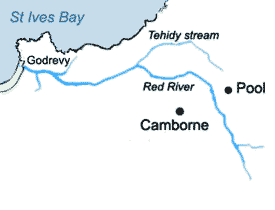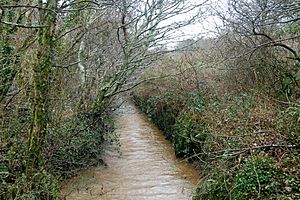Red River (Koner) facts for kids
Quick facts for kids Red River |
|
|---|---|

Map of the course of the Red River and the Tehidy Stream
|
|
| Native name | Dowr Koner |
| Country | United Kingdom |
| Region | Cornwall |
| Physical characteristics | |
| Main source | Bolenowe 50°11′32″N 5°15′20″W / 50.19222°N 5.25556°W |
| River mouth | Godrevy, St Ives Bay 50°13′42″N 5°22′59″W / 50.22833°N 5.38306°W |
| Length | 13 km (8.1 mi) |
| Basin features | |
| Tributaries |
|
The Red River (called Dowr Koner in Cornish) is a small river in north-west Cornwall, United Kingdom. It flows into St Ives Bay at Godrevy on Cornwall's Atlantic coast. The Red River is about 13 kilometers (8 miles) long. It got its name because its water used to be red from mineral deposits. These deposits came from tin mining activities nearby. The river flows downhill quite steeply, dropping 170 meters (560 feet) from where it starts to the sea.
Contents
The Red River's Journey
The Red River begins from springs near Bolenowe. This area is an upland plateau made of granite rock. The river then flows north. It passes through a narrow valley, or gorge, west of Carn Brea.
After the gorge, the river goes past Tuckingmill. Here, you can find Tuckingmill Valley Park. This area was once a busy center for mining and related industries. At a small village called Combe, the Tehidy Stream joins the Red River. From there, the Red River turns west and flows towards Godrevy.
Tin Mining and the River
The area around the Red River, including Tuckingmill, Pool, and Camborne, had many important tin mines. For hundreds of years, especially in the 1700s and 1800s, people used the river for mining.
How Mining Changed the River
The river's water was used to separate minerals and as a power source. Because of all this mining, the river changed a lot. Parts of it were moved, made into canals, or had banks built up. This means very little of the river is still in its natural state.
Collecting Tin from the River
People would collect tin from the riverbed, a process called "tin streaming." In 1872, a writer named Mr. Watson wondered if any other river in the world was as rich in tin as the Red River. The river received water from mines where tin was processed. People working on the riverbed could earn a lot of money from the tin that was washed away from the mines. By 1879, it was estimated that £30,000 worth of tin was lost by the mines each year.
Many "works" or small businesses were set up along the river. By 1885, there were 29 such places. They employed 861 people to collect the tin that escaped from the mines upstream.
Arsenic Production
Inside Tuckingmill Valley Park, there is a small island. On it are the remains of a chimney and other buildings from around 1905. These were used to produce arsenic. Arsenic became valuable when tin and copper mining started to decline. Mines built better furnaces to collect arsenic. It was used as a pesticide for cotton fields in the United States. It was also used in paints and dyes to create new colors like canary yellow.
Controlling Water Flow
You can still see high stone banks along the river. These are the remains of ten sluices. Sluices are gates that controlled the flow of water. They helped people collect the leftover mining waste, called tailings. These sluices were part of the Tolgarrick tin treatment operations, which closed in 1986.
The River's Recovery
The last mine, South Crofty, closed in 1998. Since then, the Red River has slowly lost its famous red color. Its natural environment and variety of living things are now returning. In 2017, the Environment Agency allowed the new mine owner to release water from the mine. This was to prepare for the mine possibly reopening in the future.
The river also gave its name to a local pub, the Red River Inn.
Wildlife and Ecology
The Red River is one of the most changed streams in the UK. This is because of hundreds of years of mining. The mining caused heavy metal pollution and changed the river's path. However, the river is slowly becoming more natural. Its banks are eroding, and sediment is forming bars and small islands.
Animals in Tuckingmill Valley Park
The river and ponds in Tuckingmill Valley Park are important homes for wildlife, even though they are in a town. Two rare insects found here are the scarce blue-tailed damselfly (Ischnura pumilio) and the small red damselfly (Ceriagrion tenellum).
The young of the golden-ringed dragonfly (Ceriagrion tenellum) have been found here. You can see the adult dragonflies flying in the summer and autumn. Other dragonflies include the common darter (Sympetrum striolatum) and the migrant hawker (Aeshna mixta). These usually fly in August and September.
Amphibians and Mammals
You can find frog (Rana temporaria temporaria) and common toad (Bufo bufo) eggs along the edges of the ponds early in the year. The otter (Lutra lutra) has also returned to the river. This shows that the water quality has improved.
Controlling Invasive Plants
Some invasive plants are found along the river. These include parrot feather (Myriophyllum aquaticum) and Japanese knotweed (Reynoutria japonica). Volunteers regularly remove parrot feather by hand to stop it from spreading. Japanese knotweed growth is controlled with chemical treatments.
Images for kids





